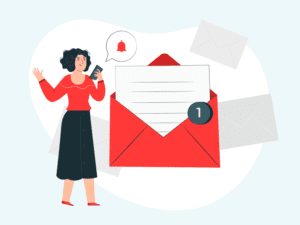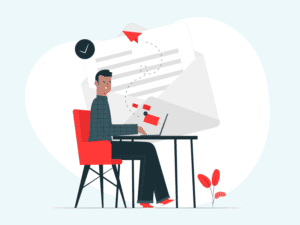Email marketing is one of the best ways to nurture leads and is used widely in all sorts of sales and marketing activities. There are two main reasons for this—it’s cheap and it’s effective.
The return on investment for emails is so much better than almost all other forms of marketing communication. But that’s not to say it’s perfect.
Unfortunately, open rates (never-mind click-through rates or other conversion metrics) are quite low. In fact, the average open rate across all industries is 17.8%. The only exception to this is welcome emails, which enjoy a higher opening rate as a rule.
This means that email marketing professionals need to get much more tactical with how they send out emails. Simply keeping leads “up to date” on your products isn’t going to elicit the reaction you want or that it used to when email marketing was still young.
Instead, the emails need to be targeted at individuals who not only represent your buyer persona but also based on the behavior they display or at predetermined times in their journey. This is where the trigger emails come in—one of the sale’s professional’s best friends.
What are trigger emails?

Imagine it’s summer and it’s over 100 degrees out. You’re in a fairly rural area with few stores and are unsure how much longer you’re able to take the heat. There’s sweat running down your brow and you keep fanning yourself.
Suddenly, a person walking by hands you a cool bottle of water. You take it gratefully and quench your thirst.
But why did the person know to give you the bottle of water? Well, because it was obvious from your behavior that you really wanted something to cool you down.
Trigger emails operate on a similar logic. To put it simply, they are emails which are automatically sent out to someone who has already subscribed to your lead database, based on a “trigger.”
The trigger can be literally anything, but the content of the email needs to match the behavior or action that the lead has taken.
Here are some examples:
Action-based emails
The trigger email we’re most familiar with is the welcome email, which can easily be turned into a series. When someone hands over their information, whether for a newsletter, ebook, or anything else, an automated email goes out welcoming them to the club.
This is an example of an action-based trigger, where the lead has performed a specific action and you want to respond with relevant content to keep them engaged. Another example of an action is when they actually make a purchase. If you have an ecommerce store, follow-up emails directly after purchase are incredible ways to add value.
Behavior-based emails
Behavior-based emails are sent out when customers exhibit certain behaviors or lack thereof. For example, if you own an ecommerce store and a regular customer doesn’t make a purchase in a certain amount of time, this can trigger an email.
Alternatively, if you see they’re making an above-average number of purchases, you may want to reward them with an offer or referral deal.
Time-based emails
Finally, we have time-based emails, which are based on information you have from when the lead signed up. Ever got an email from a company wishing you a happy birthday? This is a time-based email!
Time-based emails can also be seasonal, with different offers scheduled depending on the season, whether the holiday season, Black Friday, or whatever else.
How trigger emails are useful for sales professionals

The main benefit of trigger emails is to increase engagement among leads or recurring customers. But really, they can be applied to multiple different scenarios.
For example, they can be used to:
- Provide a smooth onboarding process.
- Keep customers informed during a purchase (i.e. confirmation emails).
- Nurture customers to improve chances of converting.
- Offer opportunities for upselling.
Depending on the type of company you have, the types of trigger emails you have will be more useful for certain situations. Let’s look at a few examples.
Trigger emails in SaaS companies
SaaS companies are the perfect staging ground for effective trigger emails. For sales professionals, it can be difficult to get potential clients to convert in the first place because you’re asking for a larger commitment. It’s not like ecommerce, where a purchase may happen on a whim.
Nurturing leads
In this context, you want to remain top of mind among your leads, by sending relevant emails based on time, behavior, or other factors. If the content matches where they are in the journey, you’re more likely to be able to get that all-important appointment that could lead to a sale.
Upgrade reminders
SaaS companies often use the freemium model, where basic features are offered for free, or a limited free trial of all. These are particularly hot leads as they have shown a lot of interest in your pservice, enough for them to actually sign up. This means that a well-timed reminder email could be enough for them to upgrade and become a premium member.
Onboarding
But trigger emails are just as useful afterwards. Once a customer does purchase your software, you can send out a series of onboarding emails which will set them up for success. With SaaS, properly educating your customers is vital for meeting expectations and ongoing satisfaction.
Trigger emails in ecommerce companies

Trigger emails are fundamental to the success of ecommerce companies. Provided you have a good CRM platform, you can guide your customers at specific moments to provide maximum value—and boost profits.
Abandoned cart
The most famous example of trigger emails in ecommerce is the abandoned cart email. We’ve all done it. We’re just about to make that purchase but there’s something holding us back or we get distracted. Then, we get an email reminding us that it’s there—and boom, we make the purchase.
Canceling the order
It’s also possible that people get cold feet after placing the order and seek to cancel. If this happens, sometimes a little extra incentive can be enough to convince them to keep their order. For example, you could waive shipping fees or give them 10% off their next purchase.
Milestones
Rewarding your most loyal customers is always a good idea. By sending out emails with offers or rewards when they hit a certain number of orders is a fantastic way to build loyalty and ensure they keep coming back.
Email marketing is simple yet effective. By leveraging the power of trigger emails, you can set up hand-free communications that go out at exactly the right time and maximize your chances of conversion.
If you’re not already using trigger emails—now is the time to incorporate them into your strategy.
At Pipeline.so, we provide an end-to-end CRM solution with powerful email marketing capabilities. If you’d like to find out more about how we can help you, please get in touch today!

